ICT: Implementing 3D Printing Technology in Australian Business
VerifiedAdded on 2021/06/17
|15
|3876
|173
Report
AI Summary
This report examines the feasibility of implementing 3D printing technology in an Australian medium-sized firm located in Melbourne. It defines 3D printing as an adaptive technology for creating physical objects from digital designs and discusses its major applications, including manufacturing, prototyping, and dental mining. The report also outlines the advantages of 3D printing, such as manufacturing a large number of products, rapid prototyping, low-cost production, eliminating involved costs, and creating opportunities for various employees. However, it also addresses the drawbacks, including counterfeiting risks, manufacturing dangerous items, and limitations in raw materials. The report concludes by providing recommendations for the firm considering adopting 3D printing technology to improve its retail and corporate client services.
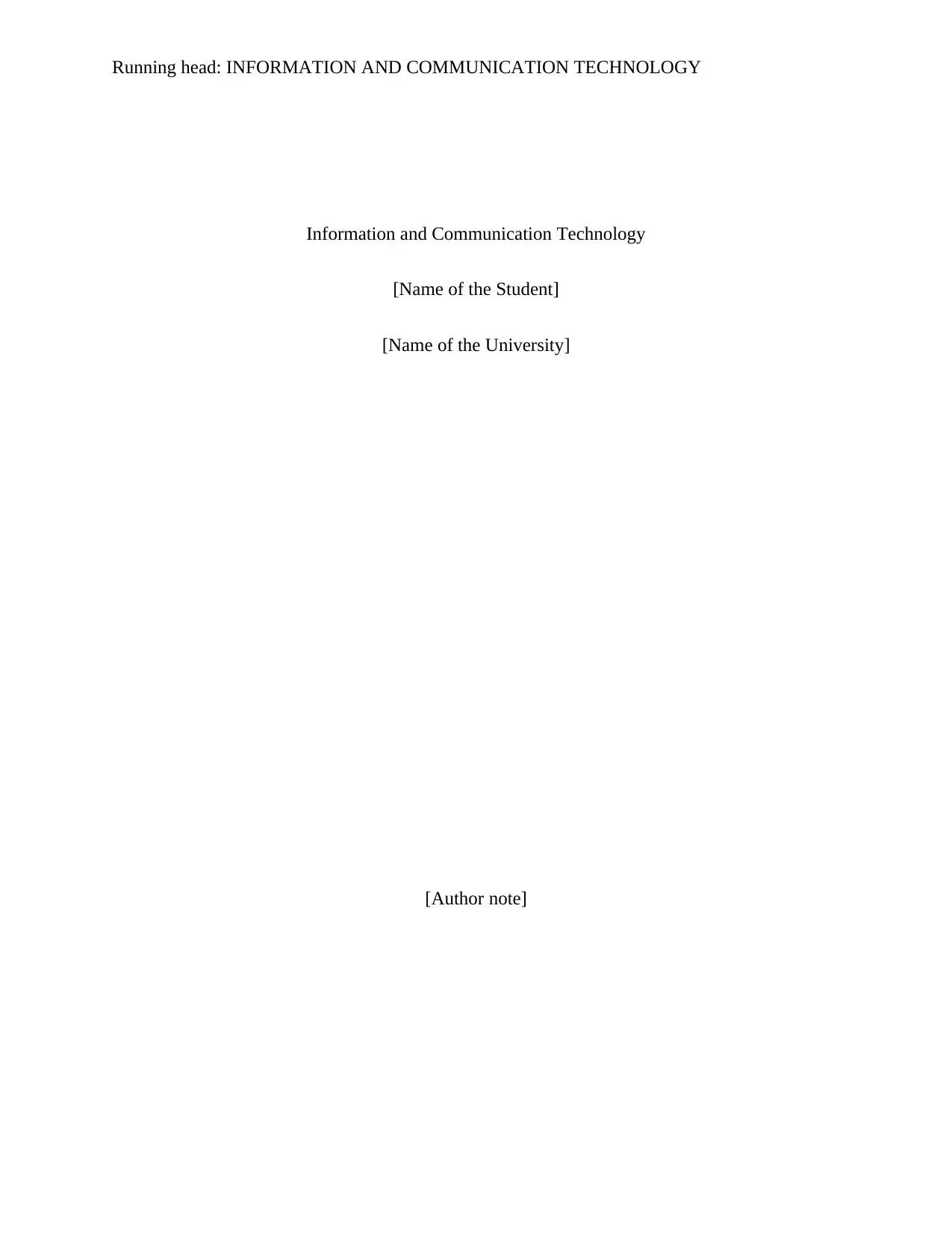
Running head: INFORMATION AND COMMUNICATION TECHNOLOGY
Information and Communication Technology
[Name of the Student]
[Name of the University]
[Author note]
Information and Communication Technology
[Name of the Student]
[Name of the University]
[Author note]
Paraphrase This Document
Need a fresh take? Get an instant paraphrase of this document with our AI Paraphraser
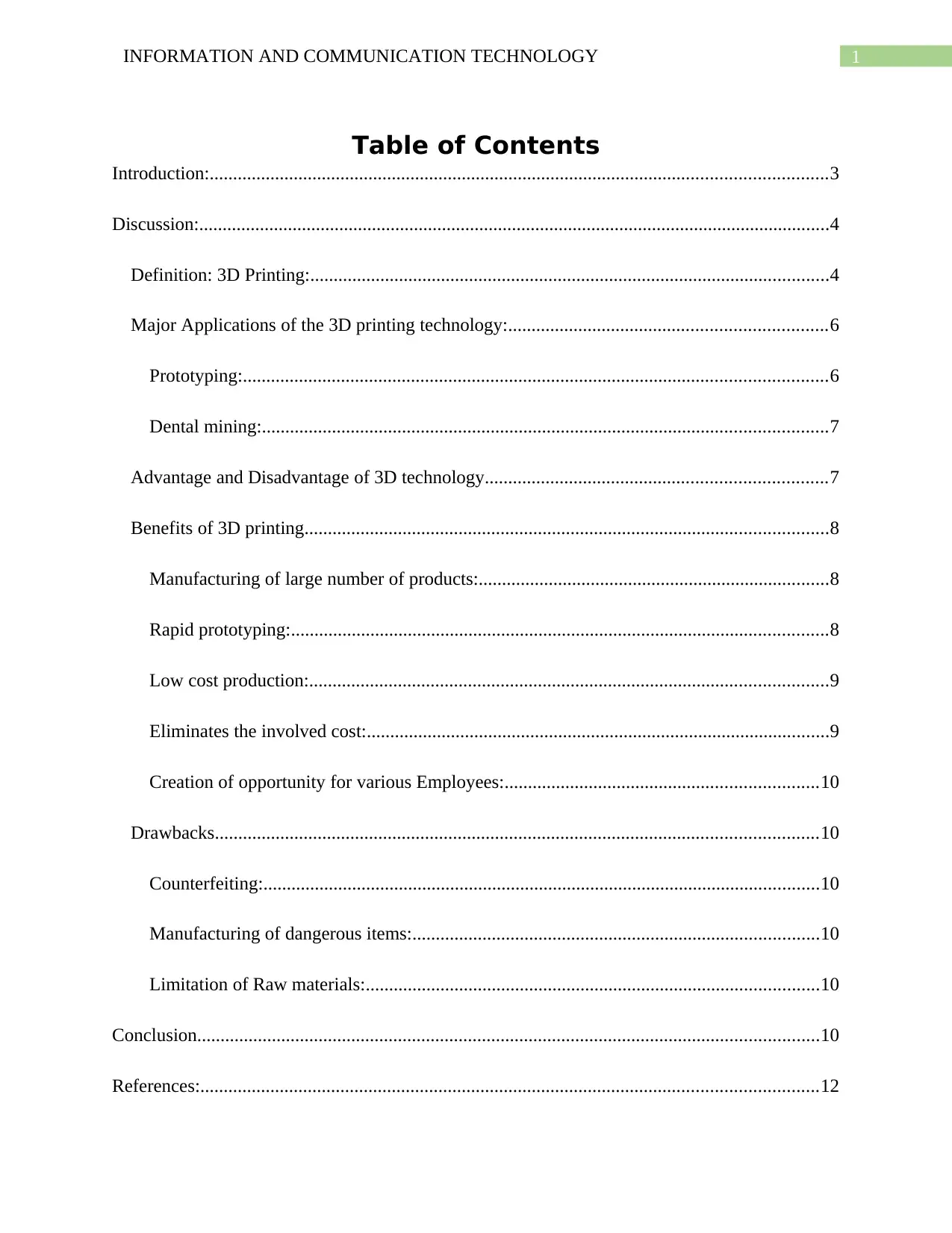
1INFORMATION AND COMMUNICATION TECHNOLOGY
Table of Contents
Introduction:....................................................................................................................................3
Discussion:.......................................................................................................................................4
Definition: 3D Printing:...............................................................................................................4
Major Applications of the 3D printing technology:....................................................................6
Prototyping:.............................................................................................................................6
Dental mining:.........................................................................................................................7
Advantage and Disadvantage of 3D technology.........................................................................7
Benefits of 3D printing................................................................................................................8
Manufacturing of large number of products:...........................................................................8
Rapid prototyping:...................................................................................................................8
Low cost production:...............................................................................................................9
Eliminates the involved cost:...................................................................................................9
Creation of opportunity for various Employees:...................................................................10
Drawbacks.................................................................................................................................10
Counterfeiting:.......................................................................................................................10
Manufacturing of dangerous items:.......................................................................................10
Limitation of Raw materials:.................................................................................................10
Conclusion.....................................................................................................................................10
References:....................................................................................................................................12
Table of Contents
Introduction:....................................................................................................................................3
Discussion:.......................................................................................................................................4
Definition: 3D Printing:...............................................................................................................4
Major Applications of the 3D printing technology:....................................................................6
Prototyping:.............................................................................................................................6
Dental mining:.........................................................................................................................7
Advantage and Disadvantage of 3D technology.........................................................................7
Benefits of 3D printing................................................................................................................8
Manufacturing of large number of products:...........................................................................8
Rapid prototyping:...................................................................................................................8
Low cost production:...............................................................................................................9
Eliminates the involved cost:...................................................................................................9
Creation of opportunity for various Employees:...................................................................10
Drawbacks.................................................................................................................................10
Counterfeiting:.......................................................................................................................10
Manufacturing of dangerous items:.......................................................................................10
Limitation of Raw materials:.................................................................................................10
Conclusion.....................................................................................................................................10
References:....................................................................................................................................12

2INFORMATION AND COMMUNICATION TECHNOLOGY
⊘ This is a preview!⊘
Do you want full access?
Subscribe today to unlock all pages.

Trusted by 1+ million students worldwide
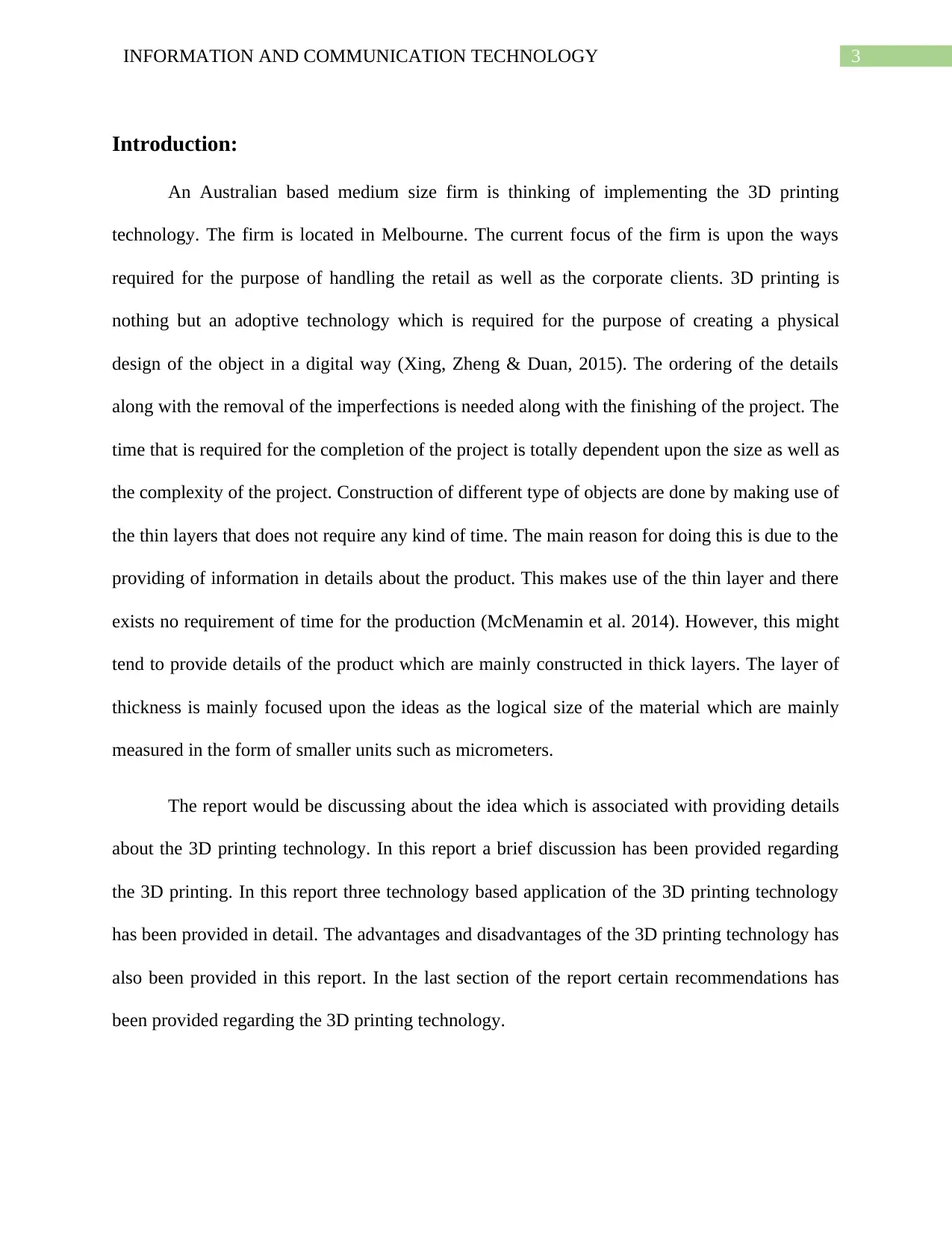
3INFORMATION AND COMMUNICATION TECHNOLOGY
Introduction:
An Australian based medium size firm is thinking of implementing the 3D printing
technology. The firm is located in Melbourne. The current focus of the firm is upon the ways
required for the purpose of handling the retail as well as the corporate clients. 3D printing is
nothing but an adoptive technology which is required for the purpose of creating a physical
design of the object in a digital way (Xing, Zheng & Duan, 2015). The ordering of the details
along with the removal of the imperfections is needed along with the finishing of the project. The
time that is required for the completion of the project is totally dependent upon the size as well as
the complexity of the project. Construction of different type of objects are done by making use of
the thin layers that does not require any kind of time. The main reason for doing this is due to the
providing of information in details about the product. This makes use of the thin layer and there
exists no requirement of time for the production (McMenamin et al. 2014). However, this might
tend to provide details of the product which are mainly constructed in thick layers. The layer of
thickness is mainly focused upon the ideas as the logical size of the material which are mainly
measured in the form of smaller units such as micrometers.
The report would be discussing about the idea which is associated with providing details
about the 3D printing technology. In this report a brief discussion has been provided regarding
the 3D printing. In this report three technology based application of the 3D printing technology
has been provided in detail. The advantages and disadvantages of the 3D printing technology has
also been provided in this report. In the last section of the report certain recommendations has
been provided regarding the 3D printing technology.
Introduction:
An Australian based medium size firm is thinking of implementing the 3D printing
technology. The firm is located in Melbourne. The current focus of the firm is upon the ways
required for the purpose of handling the retail as well as the corporate clients. 3D printing is
nothing but an adoptive technology which is required for the purpose of creating a physical
design of the object in a digital way (Xing, Zheng & Duan, 2015). The ordering of the details
along with the removal of the imperfections is needed along with the finishing of the project. The
time that is required for the completion of the project is totally dependent upon the size as well as
the complexity of the project. Construction of different type of objects are done by making use of
the thin layers that does not require any kind of time. The main reason for doing this is due to the
providing of information in details about the product. This makes use of the thin layer and there
exists no requirement of time for the production (McMenamin et al. 2014). However, this might
tend to provide details of the product which are mainly constructed in thick layers. The layer of
thickness is mainly focused upon the ideas as the logical size of the material which are mainly
measured in the form of smaller units such as micrometers.
The report would be discussing about the idea which is associated with providing details
about the 3D printing technology. In this report a brief discussion has been provided regarding
the 3D printing. In this report three technology based application of the 3D printing technology
has been provided in detail. The advantages and disadvantages of the 3D printing technology has
also been provided in this report. In the last section of the report certain recommendations has
been provided regarding the 3D printing technology.
Paraphrase This Document
Need a fresh take? Get an instant paraphrase of this document with our AI Paraphraser
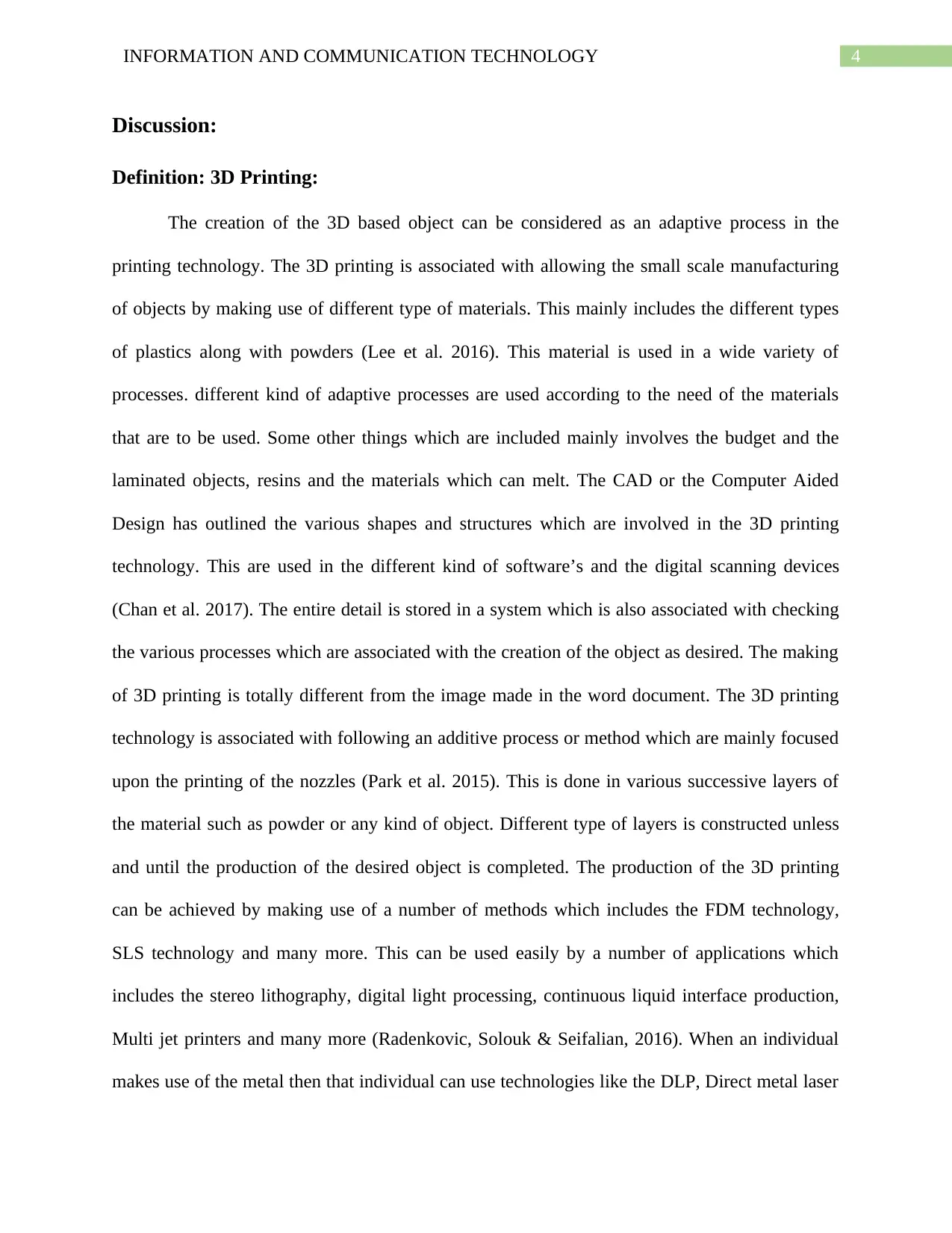
4INFORMATION AND COMMUNICATION TECHNOLOGY
Discussion:
Definition: 3D Printing:
The creation of the 3D based object can be considered as an adaptive process in the
printing technology. The 3D printing is associated with allowing the small scale manufacturing
of objects by making use of different type of materials. This mainly includes the different types
of plastics along with powders (Lee et al. 2016). This material is used in a wide variety of
processes. different kind of adaptive processes are used according to the need of the materials
that are to be used. Some other things which are included mainly involves the budget and the
laminated objects, resins and the materials which can melt. The CAD or the Computer Aided
Design has outlined the various shapes and structures which are involved in the 3D printing
technology. This are used in the different kind of software’s and the digital scanning devices
(Chan et al. 2017). The entire detail is stored in a system which is also associated with checking
the various processes which are associated with the creation of the object as desired. The making
of 3D printing is totally different from the image made in the word document. The 3D printing
technology is associated with following an additive process or method which are mainly focused
upon the printing of the nozzles (Park et al. 2015). This is done in various successive layers of
the material such as powder or any kind of object. Different type of layers is constructed unless
and until the production of the desired object is completed. The production of the 3D printing
can be achieved by making use of a number of methods which includes the FDM technology,
SLS technology and many more. This can be used easily by a number of applications which
includes the stereo lithography, digital light processing, continuous liquid interface production,
Multi jet printers and many more (Radenkovic, Solouk & Seifalian, 2016). When an individual
makes use of the metal then that individual can use technologies like the DLP, Direct metal laser
Discussion:
Definition: 3D Printing:
The creation of the 3D based object can be considered as an adaptive process in the
printing technology. The 3D printing is associated with allowing the small scale manufacturing
of objects by making use of different type of materials. This mainly includes the different types
of plastics along with powders (Lee et al. 2016). This material is used in a wide variety of
processes. different kind of adaptive processes are used according to the need of the materials
that are to be used. Some other things which are included mainly involves the budget and the
laminated objects, resins and the materials which can melt. The CAD or the Computer Aided
Design has outlined the various shapes and structures which are involved in the 3D printing
technology. This are used in the different kind of software’s and the digital scanning devices
(Chan et al. 2017). The entire detail is stored in a system which is also associated with checking
the various processes which are associated with the creation of the object as desired. The making
of 3D printing is totally different from the image made in the word document. The 3D printing
technology is associated with following an additive process or method which are mainly focused
upon the printing of the nozzles (Park et al. 2015). This is done in various successive layers of
the material such as powder or any kind of object. Different type of layers is constructed unless
and until the production of the desired object is completed. The production of the 3D printing
can be achieved by making use of a number of methods which includes the FDM technology,
SLS technology and many more. This can be used easily by a number of applications which
includes the stereo lithography, digital light processing, continuous liquid interface production,
Multi jet printers and many more (Radenkovic, Solouk & Seifalian, 2016). When an individual
makes use of the metal then that individual can use technologies like the DLP, Direct metal laser
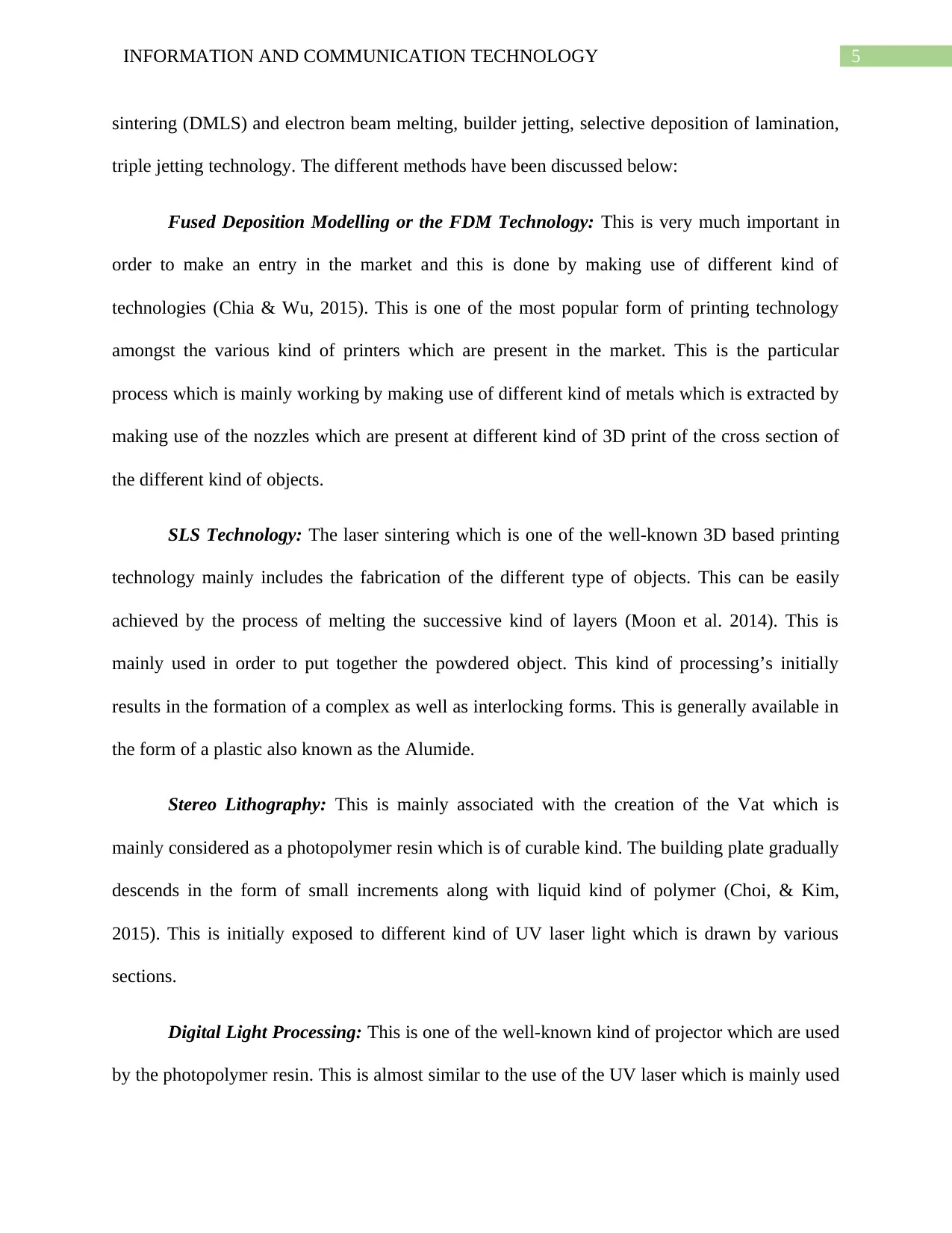
5INFORMATION AND COMMUNICATION TECHNOLOGY
sintering (DMLS) and electron beam melting, builder jetting, selective deposition of lamination,
triple jetting technology. The different methods have been discussed below:
Fused Deposition Modelling or the FDM Technology: This is very much important in
order to make an entry in the market and this is done by making use of different kind of
technologies (Chia & Wu, 2015). This is one of the most popular form of printing technology
amongst the various kind of printers which are present in the market. This is the particular
process which is mainly working by making use of different kind of metals which is extracted by
making use of the nozzles which are present at different kind of 3D print of the cross section of
the different kind of objects.
SLS Technology: The laser sintering which is one of the well-known 3D based printing
technology mainly includes the fabrication of the different type of objects. This can be easily
achieved by the process of melting the successive kind of layers (Moon et al. 2014). This is
mainly used in order to put together the powdered object. This kind of processing’s initially
results in the formation of a complex as well as interlocking forms. This is generally available in
the form of a plastic also known as the Alumide.
Stereo Lithography: This is mainly associated with the creation of the Vat which is
mainly considered as a photopolymer resin which is of curable kind. The building plate gradually
descends in the form of small increments along with liquid kind of polymer (Choi, & Kim,
2015). This is initially exposed to different kind of UV laser light which is drawn by various
sections.
Digital Light Processing: This is one of the well-known kind of projector which are used
by the photopolymer resin. This is almost similar to the use of the UV laser which is mainly used
sintering (DMLS) and electron beam melting, builder jetting, selective deposition of lamination,
triple jetting technology. The different methods have been discussed below:
Fused Deposition Modelling or the FDM Technology: This is very much important in
order to make an entry in the market and this is done by making use of different kind of
technologies (Chia & Wu, 2015). This is one of the most popular form of printing technology
amongst the various kind of printers which are present in the market. This is the particular
process which is mainly working by making use of different kind of metals which is extracted by
making use of the nozzles which are present at different kind of 3D print of the cross section of
the different kind of objects.
SLS Technology: The laser sintering which is one of the well-known 3D based printing
technology mainly includes the fabrication of the different type of objects. This can be easily
achieved by the process of melting the successive kind of layers (Moon et al. 2014). This is
mainly used in order to put together the powdered object. This kind of processing’s initially
results in the formation of a complex as well as interlocking forms. This is generally available in
the form of a plastic also known as the Alumide.
Stereo Lithography: This is mainly associated with the creation of the Vat which is
mainly considered as a photopolymer resin which is of curable kind. The building plate gradually
descends in the form of small increments along with liquid kind of polymer (Choi, & Kim,
2015). This is initially exposed to different kind of UV laser light which is drawn by various
sections.
Digital Light Processing: This is one of the well-known kind of projector which are used
by the photopolymer resin. This is almost similar to the use of the UV laser which is mainly used
⊘ This is a preview!⊘
Do you want full access?
Subscribe today to unlock all pages.

Trusted by 1+ million students worldwide
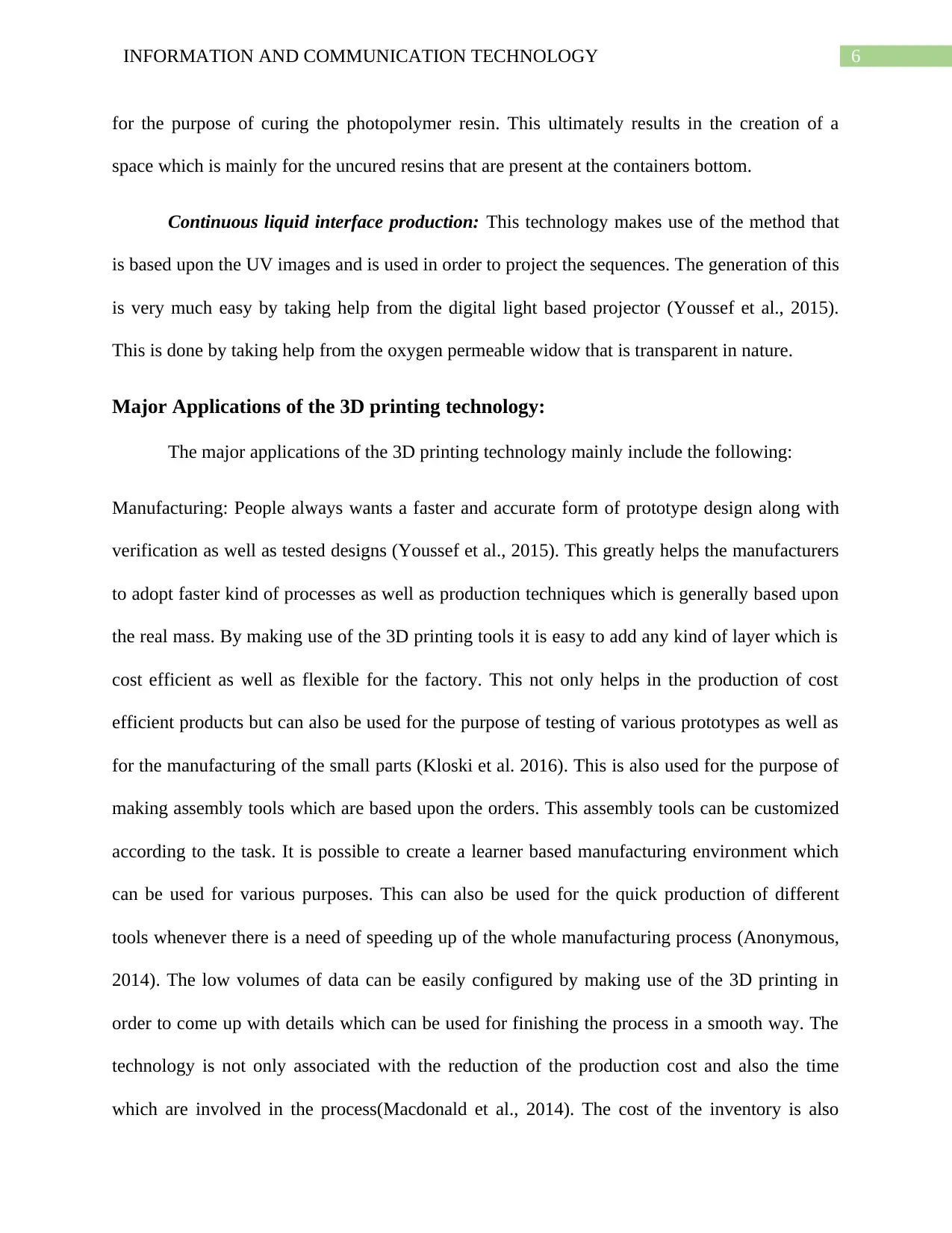
6INFORMATION AND COMMUNICATION TECHNOLOGY
for the purpose of curing the photopolymer resin. This ultimately results in the creation of a
space which is mainly for the uncured resins that are present at the containers bottom.
Continuous liquid interface production: This technology makes use of the method that
is based upon the UV images and is used in order to project the sequences. The generation of this
is very much easy by taking help from the digital light based projector (Youssef et al., 2015).
This is done by taking help from the oxygen permeable widow that is transparent in nature.
Major Applications of the 3D printing technology:
The major applications of the 3D printing technology mainly include the following:
Manufacturing: People always wants a faster and accurate form of prototype design along with
verification as well as tested designs (Youssef et al., 2015). This greatly helps the manufacturers
to adopt faster kind of processes as well as production techniques which is generally based upon
the real mass. By making use of the 3D printing tools it is easy to add any kind of layer which is
cost efficient as well as flexible for the factory. This not only helps in the production of cost
efficient products but can also be used for the purpose of testing of various prototypes as well as
for the manufacturing of the small parts (Kloski et al. 2016). This is also used for the purpose of
making assembly tools which are based upon the orders. This assembly tools can be customized
according to the task. It is possible to create a learner based manufacturing environment which
can be used for various purposes. This can also be used for the quick production of different
tools whenever there is a need of speeding up of the whole manufacturing process (Anonymous,
2014). The low volumes of data can be easily configured by making use of the 3D printing in
order to come up with details which can be used for finishing the process in a smooth way. The
technology is not only associated with the reduction of the production cost and also the time
which are involved in the process(Macdonald et al., 2014). The cost of the inventory is also
for the purpose of curing the photopolymer resin. This ultimately results in the creation of a
space which is mainly for the uncured resins that are present at the containers bottom.
Continuous liquid interface production: This technology makes use of the method that
is based upon the UV images and is used in order to project the sequences. The generation of this
is very much easy by taking help from the digital light based projector (Youssef et al., 2015).
This is done by taking help from the oxygen permeable widow that is transparent in nature.
Major Applications of the 3D printing technology:
The major applications of the 3D printing technology mainly include the following:
Manufacturing: People always wants a faster and accurate form of prototype design along with
verification as well as tested designs (Youssef et al., 2015). This greatly helps the manufacturers
to adopt faster kind of processes as well as production techniques which is generally based upon
the real mass. By making use of the 3D printing tools it is easy to add any kind of layer which is
cost efficient as well as flexible for the factory. This not only helps in the production of cost
efficient products but can also be used for the purpose of testing of various prototypes as well as
for the manufacturing of the small parts (Kloski et al. 2016). This is also used for the purpose of
making assembly tools which are based upon the orders. This assembly tools can be customized
according to the task. It is possible to create a learner based manufacturing environment which
can be used for various purposes. This can also be used for the quick production of different
tools whenever there is a need of speeding up of the whole manufacturing process (Anonymous,
2014). The low volumes of data can be easily configured by making use of the 3D printing in
order to come up with details which can be used for finishing the process in a smooth way. The
technology is not only associated with the reduction of the production cost and also the time
which are involved in the process(Macdonald et al., 2014). The cost of the inventory is also
Paraphrase This Document
Need a fresh take? Get an instant paraphrase of this document with our AI Paraphraser
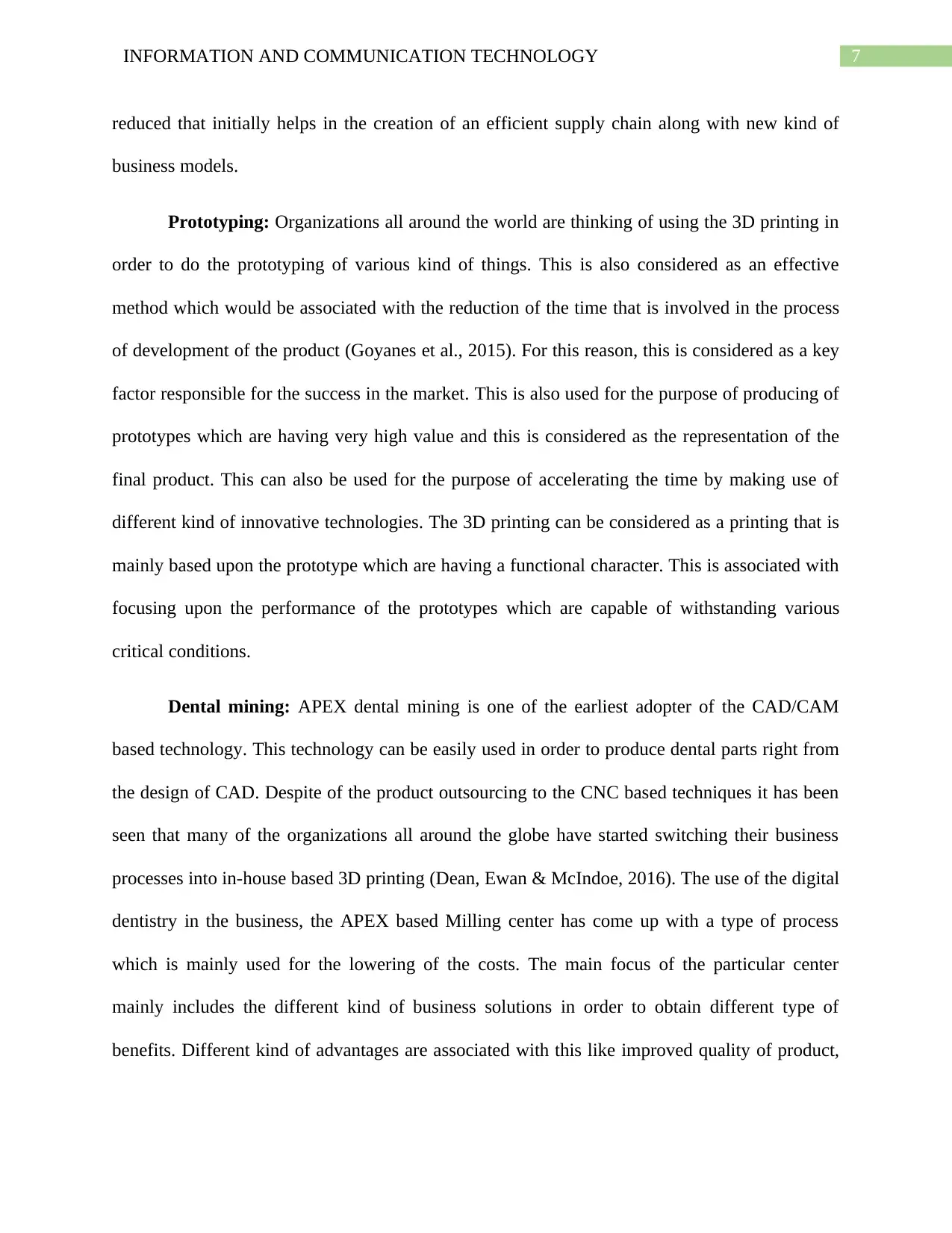
7INFORMATION AND COMMUNICATION TECHNOLOGY
reduced that initially helps in the creation of an efficient supply chain along with new kind of
business models.
Prototyping: Organizations all around the world are thinking of using the 3D printing in
order to do the prototyping of various kind of things. This is also considered as an effective
method which would be associated with the reduction of the time that is involved in the process
of development of the product (Goyanes et al., 2015). For this reason, this is considered as a key
factor responsible for the success in the market. This is also used for the purpose of producing of
prototypes which are having very high value and this is considered as the representation of the
final product. This can also be used for the purpose of accelerating the time by making use of
different kind of innovative technologies. The 3D printing can be considered as a printing that is
mainly based upon the prototype which are having a functional character. This is associated with
focusing upon the performance of the prototypes which are capable of withstanding various
critical conditions.
Dental mining: APEX dental mining is one of the earliest adopter of the CAD/CAM
based technology. This technology can be easily used in order to produce dental parts right from
the design of CAD. Despite of the product outsourcing to the CNC based techniques it has been
seen that many of the organizations all around the globe have started switching their business
processes into in-house based 3D printing (Dean, Ewan & McIndoe, 2016). The use of the digital
dentistry in the business, the APEX based Milling center has come up with a type of process
which is mainly used for the lowering of the costs. The main focus of the particular center
mainly includes the different kind of business solutions in order to obtain different type of
benefits. Different kind of advantages are associated with this like improved quality of product,
reduced that initially helps in the creation of an efficient supply chain along with new kind of
business models.
Prototyping: Organizations all around the world are thinking of using the 3D printing in
order to do the prototyping of various kind of things. This is also considered as an effective
method which would be associated with the reduction of the time that is involved in the process
of development of the product (Goyanes et al., 2015). For this reason, this is considered as a key
factor responsible for the success in the market. This is also used for the purpose of producing of
prototypes which are having very high value and this is considered as the representation of the
final product. This can also be used for the purpose of accelerating the time by making use of
different kind of innovative technologies. The 3D printing can be considered as a printing that is
mainly based upon the prototype which are having a functional character. This is associated with
focusing upon the performance of the prototypes which are capable of withstanding various
critical conditions.
Dental mining: APEX dental mining is one of the earliest adopter of the CAD/CAM
based technology. This technology can be easily used in order to produce dental parts right from
the design of CAD. Despite of the product outsourcing to the CNC based techniques it has been
seen that many of the organizations all around the globe have started switching their business
processes into in-house based 3D printing (Dean, Ewan & McIndoe, 2016). The use of the digital
dentistry in the business, the APEX based Milling center has come up with a type of process
which is mainly used for the lowering of the costs. The main focus of the particular center
mainly includes the different kind of business solutions in order to obtain different type of
benefits. Different kind of advantages are associated with this like improved quality of product,
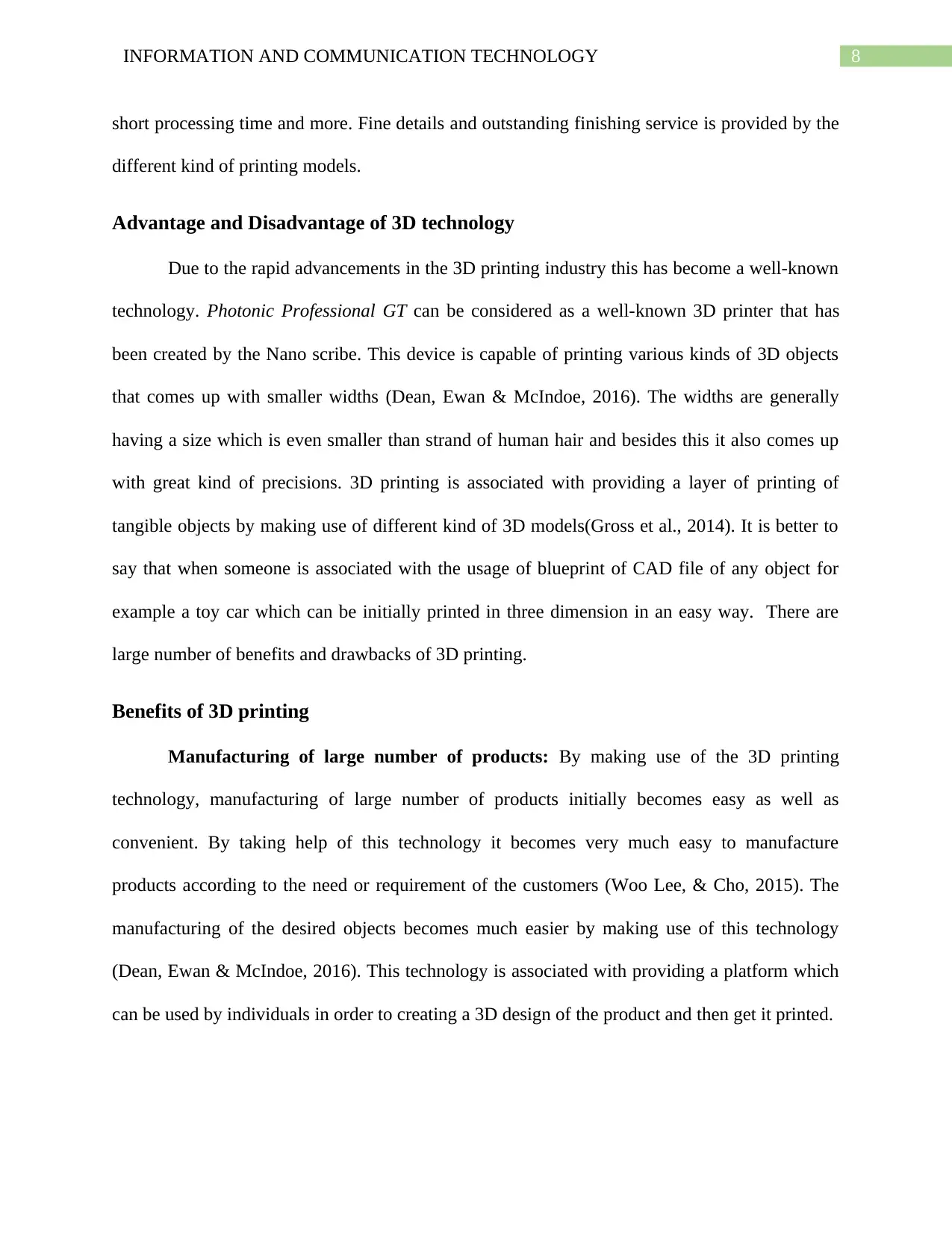
8INFORMATION AND COMMUNICATION TECHNOLOGY
short processing time and more. Fine details and outstanding finishing service is provided by the
different kind of printing models.
Advantage and Disadvantage of 3D technology
Due to the rapid advancements in the 3D printing industry this has become a well-known
technology. Photonic Professional GT can be considered as a well-known 3D printer that has
been created by the Nano scribe. This device is capable of printing various kinds of 3D objects
that comes up with smaller widths (Dean, Ewan & McIndoe, 2016). The widths are generally
having a size which is even smaller than strand of human hair and besides this it also comes up
with great kind of precisions. 3D printing is associated with providing a layer of printing of
tangible objects by making use of different kind of 3D models(Gross et al., 2014). It is better to
say that when someone is associated with the usage of blueprint of CAD file of any object for
example a toy car which can be initially printed in three dimension in an easy way. There are
large number of benefits and drawbacks of 3D printing.
Benefits of 3D printing
Manufacturing of large number of products: By making use of the 3D printing
technology, manufacturing of large number of products initially becomes easy as well as
convenient. By taking help of this technology it becomes very much easy to manufacture
products according to the need or requirement of the customers (Woo Lee, & Cho, 2015). The
manufacturing of the desired objects becomes much easier by making use of this technology
(Dean, Ewan & McIndoe, 2016). This technology is associated with providing a platform which
can be used by individuals in order to creating a 3D design of the product and then get it printed.
short processing time and more. Fine details and outstanding finishing service is provided by the
different kind of printing models.
Advantage and Disadvantage of 3D technology
Due to the rapid advancements in the 3D printing industry this has become a well-known
technology. Photonic Professional GT can be considered as a well-known 3D printer that has
been created by the Nano scribe. This device is capable of printing various kinds of 3D objects
that comes up with smaller widths (Dean, Ewan & McIndoe, 2016). The widths are generally
having a size which is even smaller than strand of human hair and besides this it also comes up
with great kind of precisions. 3D printing is associated with providing a layer of printing of
tangible objects by making use of different kind of 3D models(Gross et al., 2014). It is better to
say that when someone is associated with the usage of blueprint of CAD file of any object for
example a toy car which can be initially printed in three dimension in an easy way. There are
large number of benefits and drawbacks of 3D printing.
Benefits of 3D printing
Manufacturing of large number of products: By making use of the 3D printing
technology, manufacturing of large number of products initially becomes easy as well as
convenient. By taking help of this technology it becomes very much easy to manufacture
products according to the need or requirement of the customers (Woo Lee, & Cho, 2015). The
manufacturing of the desired objects becomes much easier by making use of this technology
(Dean, Ewan & McIndoe, 2016). This technology is associated with providing a platform which
can be used by individuals in order to creating a 3D design of the product and then get it printed.
⊘ This is a preview!⊘
Do you want full access?
Subscribe today to unlock all pages.

Trusted by 1+ million students worldwide
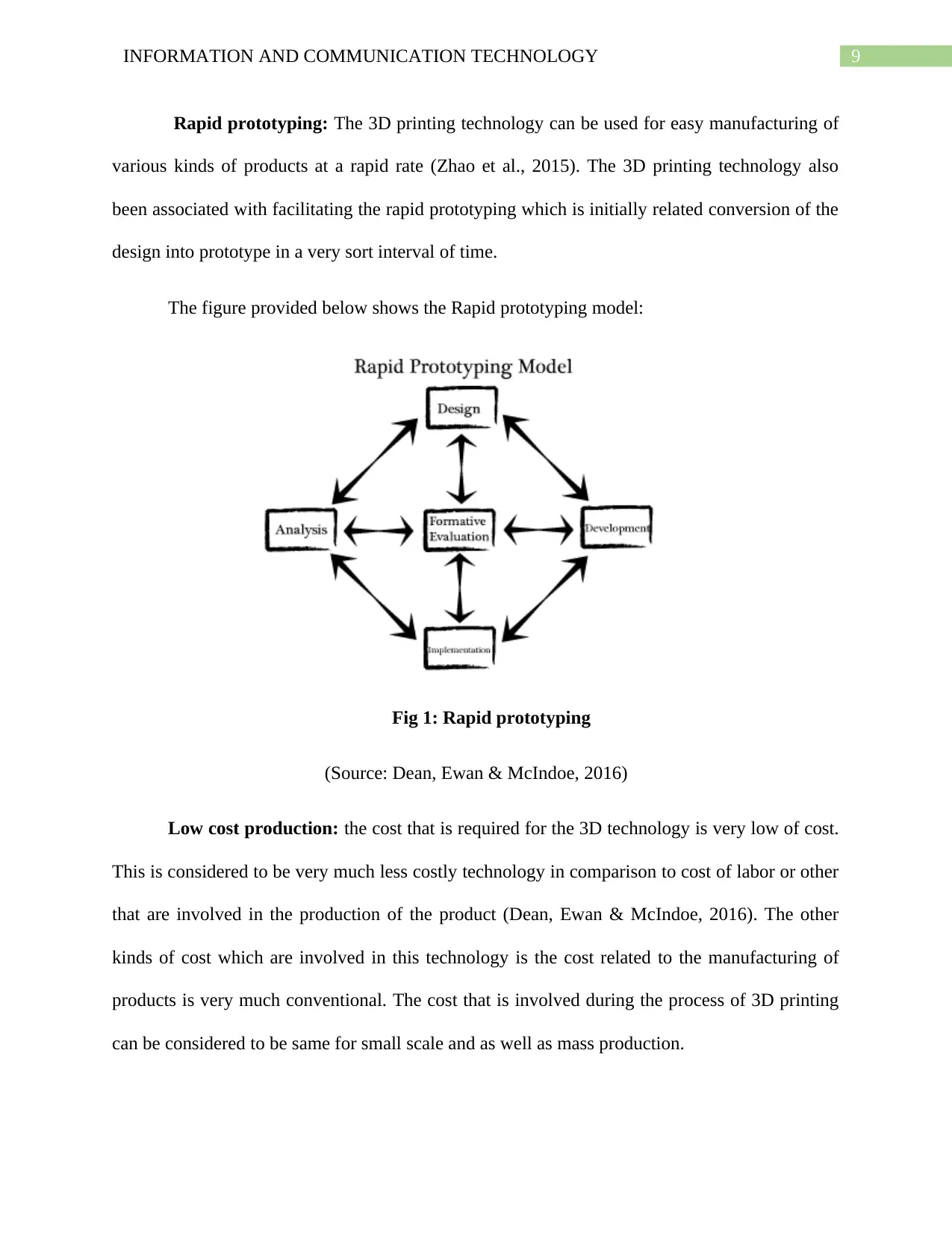
9INFORMATION AND COMMUNICATION TECHNOLOGY
Rapid prototyping: The 3D printing technology can be used for easy manufacturing of
various kinds of products at a rapid rate (Zhao et al., 2015). The 3D printing technology also
been associated with facilitating the rapid prototyping which is initially related conversion of the
design into prototype in a very sort interval of time.
The figure provided below shows the Rapid prototyping model:
Fig 1: Rapid prototyping
(Source: Dean, Ewan & McIndoe, 2016)
Low cost production: the cost that is required for the 3D technology is very low of cost.
This is considered to be very much less costly technology in comparison to cost of labor or other
that are involved in the production of the product (Dean, Ewan & McIndoe, 2016). The other
kinds of cost which are involved in this technology is the cost related to the manufacturing of
products is very much conventional. The cost that is involved during the process of 3D printing
can be considered to be same for small scale and as well as mass production.
Rapid prototyping: The 3D printing technology can be used for easy manufacturing of
various kinds of products at a rapid rate (Zhao et al., 2015). The 3D printing technology also
been associated with facilitating the rapid prototyping which is initially related conversion of the
design into prototype in a very sort interval of time.
The figure provided below shows the Rapid prototyping model:
Fig 1: Rapid prototyping
(Source: Dean, Ewan & McIndoe, 2016)
Low cost production: the cost that is required for the 3D technology is very low of cost.
This is considered to be very much less costly technology in comparison to cost of labor or other
that are involved in the production of the product (Dean, Ewan & McIndoe, 2016). The other
kinds of cost which are involved in this technology is the cost related to the manufacturing of
products is very much conventional. The cost that is involved during the process of 3D printing
can be considered to be same for small scale and as well as mass production.
Paraphrase This Document
Need a fresh take? Get an instant paraphrase of this document with our AI Paraphraser
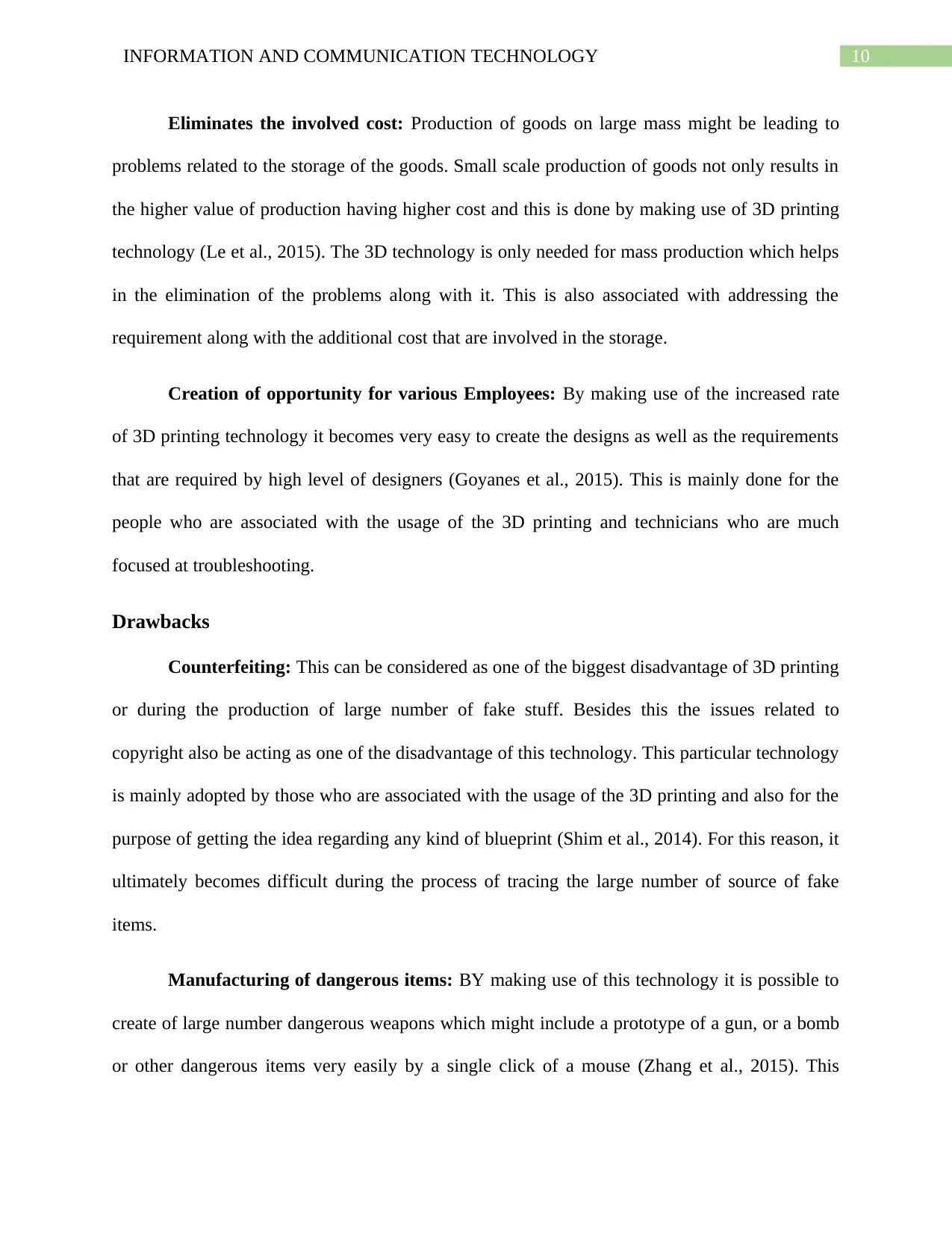
10INFORMATION AND COMMUNICATION TECHNOLOGY
Eliminates the involved cost: Production of goods on large mass might be leading to
problems related to the storage of the goods. Small scale production of goods not only results in
the higher value of production having higher cost and this is done by making use of 3D printing
technology (Le et al., 2015). The 3D technology is only needed for mass production which helps
in the elimination of the problems along with it. This is also associated with addressing the
requirement along with the additional cost that are involved in the storage.
Creation of opportunity for various Employees: By making use of the increased rate
of 3D printing technology it becomes very easy to create the designs as well as the requirements
that are required by high level of designers (Goyanes et al., 2015). This is mainly done for the
people who are associated with the usage of the 3D printing and technicians who are much
focused at troubleshooting.
Drawbacks
Counterfeiting: This can be considered as one of the biggest disadvantage of 3D printing
or during the production of large number of fake stuff. Besides this the issues related to
copyright also be acting as one of the disadvantage of this technology. This particular technology
is mainly adopted by those who are associated with the usage of the 3D printing and also for the
purpose of getting the idea regarding any kind of blueprint (Shim et al., 2014). For this reason, it
ultimately becomes difficult during the process of tracing the large number of source of fake
items.
Manufacturing of dangerous items: BY making use of this technology it is possible to
create of large number dangerous weapons which might include a prototype of a gun, or a bomb
or other dangerous items very easily by a single click of a mouse (Zhang et al., 2015). This
Eliminates the involved cost: Production of goods on large mass might be leading to
problems related to the storage of the goods. Small scale production of goods not only results in
the higher value of production having higher cost and this is done by making use of 3D printing
technology (Le et al., 2015). The 3D technology is only needed for mass production which helps
in the elimination of the problems along with it. This is also associated with addressing the
requirement along with the additional cost that are involved in the storage.
Creation of opportunity for various Employees: By making use of the increased rate
of 3D printing technology it becomes very easy to create the designs as well as the requirements
that are required by high level of designers (Goyanes et al., 2015). This is mainly done for the
people who are associated with the usage of the 3D printing and technicians who are much
focused at troubleshooting.
Drawbacks
Counterfeiting: This can be considered as one of the biggest disadvantage of 3D printing
or during the production of large number of fake stuff. Besides this the issues related to
copyright also be acting as one of the disadvantage of this technology. This particular technology
is mainly adopted by those who are associated with the usage of the 3D printing and also for the
purpose of getting the idea regarding any kind of blueprint (Shim et al., 2014). For this reason, it
ultimately becomes difficult during the process of tracing the large number of source of fake
items.
Manufacturing of dangerous items: BY making use of this technology it is possible to
create of large number dangerous weapons which might include a prototype of a gun, or a bomb
or other dangerous items very easily by a single click of a mouse (Zhang et al., 2015). This
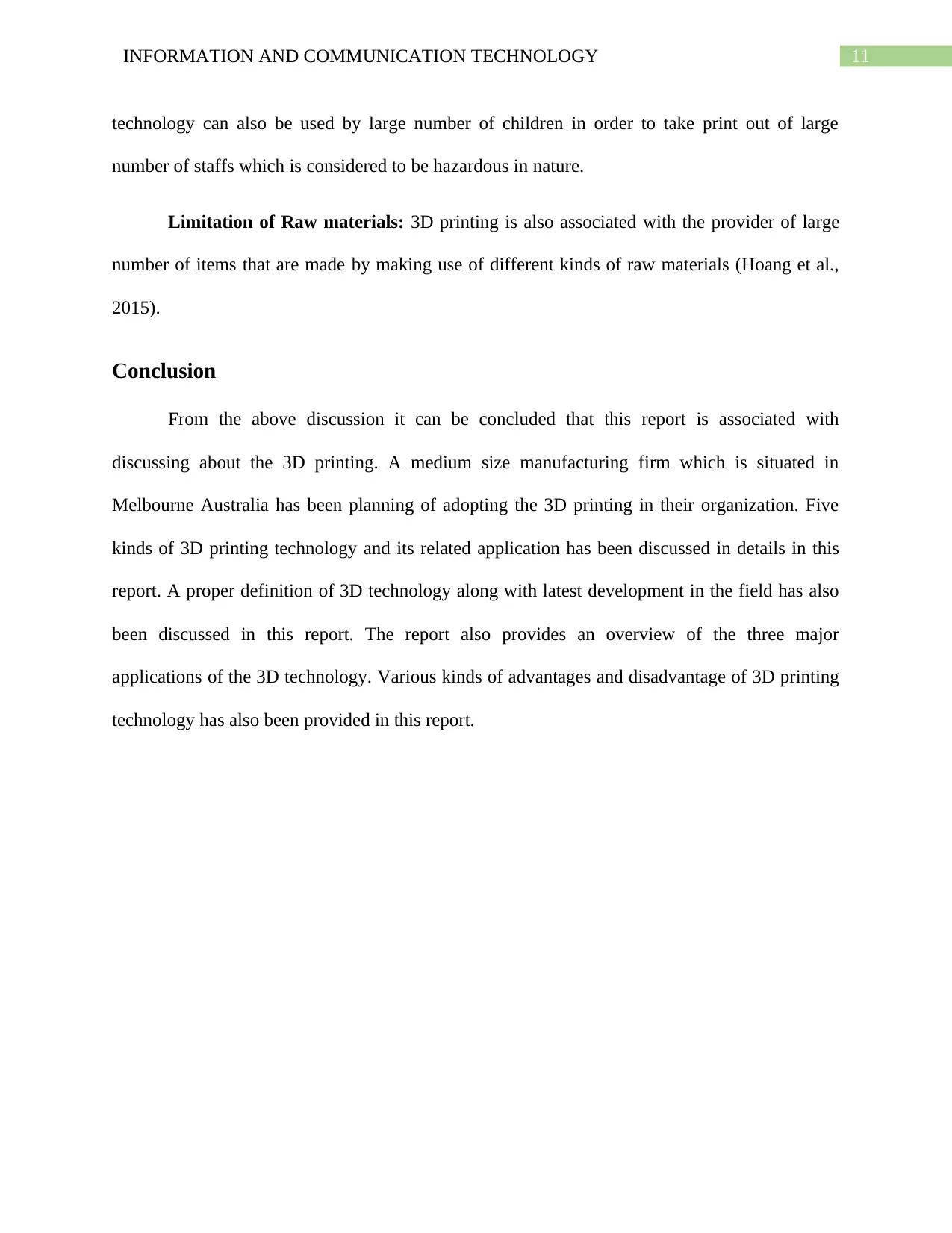
11INFORMATION AND COMMUNICATION TECHNOLOGY
technology can also be used by large number of children in order to take print out of large
number of staffs which is considered to be hazardous in nature.
Limitation of Raw materials: 3D printing is also associated with the provider of large
number of items that are made by making use of different kinds of raw materials (Hoang et al.,
2015).
Conclusion
From the above discussion it can be concluded that this report is associated with
discussing about the 3D printing. A medium size manufacturing firm which is situated in
Melbourne Australia has been planning of adopting the 3D printing in their organization. Five
kinds of 3D printing technology and its related application has been discussed in details in this
report. A proper definition of 3D technology along with latest development in the field has also
been discussed in this report. The report also provides an overview of the three major
applications of the 3D technology. Various kinds of advantages and disadvantage of 3D printing
technology has also been provided in this report.
technology can also be used by large number of children in order to take print out of large
number of staffs which is considered to be hazardous in nature.
Limitation of Raw materials: 3D printing is also associated with the provider of large
number of items that are made by making use of different kinds of raw materials (Hoang et al.,
2015).
Conclusion
From the above discussion it can be concluded that this report is associated with
discussing about the 3D printing. A medium size manufacturing firm which is situated in
Melbourne Australia has been planning of adopting the 3D printing in their organization. Five
kinds of 3D printing technology and its related application has been discussed in details in this
report. A proper definition of 3D technology along with latest development in the field has also
been discussed in this report. The report also provides an overview of the three major
applications of the 3D technology. Various kinds of advantages and disadvantage of 3D printing
technology has also been provided in this report.
⊘ This is a preview!⊘
Do you want full access?
Subscribe today to unlock all pages.

Trusted by 1+ million students worldwide
1 out of 15
Related Documents
Your All-in-One AI-Powered Toolkit for Academic Success.
+13062052269
info@desklib.com
Available 24*7 on WhatsApp / Email
![[object Object]](/_next/static/media/star-bottom.7253800d.svg)
Unlock your academic potential
Copyright © 2020–2025 A2Z Services. All Rights Reserved. Developed and managed by ZUCOL.





